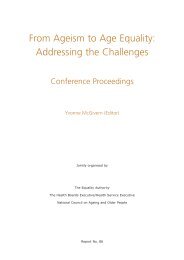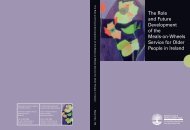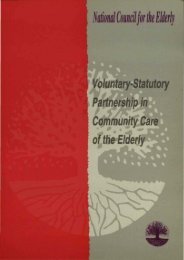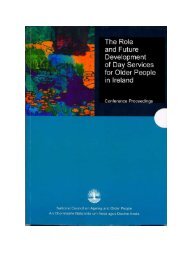Improving Quality of Life for Older People in Long-Stay Care ...
Improving Quality of Life for Older People in Long-Stay Care ...
Improving Quality of Life for Older People in Long-Stay Care ...
- No tags were found...
Create successful ePaper yourself
Turn your PDF publications into a flip-book with our unique Google optimized e-Paper software.
MethodologyA mixed method research design was selected <strong>for</strong> this study as the aim was toexplore the quality <strong>of</strong> life <strong>of</strong> older people liv<strong>in</strong>g <strong>in</strong> long-stay care from a number <strong>of</strong>perspectives. Three methods were employed with<strong>in</strong> this study: focus groups withmanagers; quantitative survey <strong>of</strong> long-stay facilities; and qualitative <strong>in</strong>terviews withresidents, relatives and staff.Focus group <strong>in</strong>terviews and analysis were undertaken prior to other data collectionas they <strong>in</strong><strong>for</strong>med the development <strong>of</strong> the survey <strong>in</strong>struments and provided,alongside the literature review, contextual <strong>in</strong><strong>for</strong>mation on factors that <strong>in</strong>fluenceresidents’ quality <strong>of</strong> life and care provision <strong>in</strong> general. Focus groups enabled importantbackground <strong>in</strong><strong>for</strong>mation on quality issues <strong>in</strong> long-stay care to be gathered. Sevenfocus groups were held with managers/proprietors <strong>of</strong> long-stay facilities. A purposeful,stratified sampl<strong>in</strong>g strategy was employed to ensure that representatives from fivetypes <strong>of</strong> facilities (geriatric hospital/home, health board district hospital/communityhospital, health board welfare home, voluntary geriatric home/hospital, and privatenurs<strong>in</strong>g home), three sectors (public, voluntary and private) and a mix <strong>of</strong> facilities(large, small and geographical sett<strong>in</strong>g) were <strong>in</strong>vited to participate. In all, 67 managersparticipated <strong>in</strong> focus groups held <strong>in</strong> Donegal, Dubl<strong>in</strong>, Cork and Galway.27The survey <strong>of</strong> all long-stay facilities extends and develops previous work by thethen National Council <strong>for</strong> the Aged (now the NCAOP) on quality <strong>of</strong> life <strong>in</strong> private andvoluntary nurs<strong>in</strong>g homes <strong>in</strong> Ireland (O’Connor and Thompstone, 1986). All 556 longstayfacilities <strong>in</strong> Ireland were surveyed. The f<strong>in</strong>al response rate was 332 giv<strong>in</strong>g aresponse rate <strong>of</strong> 62 per cent. The response varied across facility type; the highestrate was achieved <strong>in</strong> welfare homes (95 per cent) and the lowest <strong>in</strong> private nurs<strong>in</strong>ghomes (56 per cent). The quantitative survey <strong>of</strong> long-stay facilities was designed toprovide an <strong>in</strong>sight <strong>in</strong>to the likely impact <strong>of</strong> physical, environmental and staff<strong>in</strong>gissues on older people’s quality <strong>of</strong> life.The qualitative <strong>in</strong>terview data provided <strong>in</strong><strong>for</strong>mation on resident and staff perceptions<strong>of</strong> quality <strong>of</strong> life <strong>in</strong> long-stay care. 2 The focus was on environmentally-related quality<strong>of</strong> life issues (both physical and social) rather than on the <strong>in</strong>dividual health andfunctional capacity <strong>of</strong> respondents, although some data was collected on the latter.2 <strong>Long</strong>-stay care is provided to those who reside permanently with<strong>in</strong> a facility.















